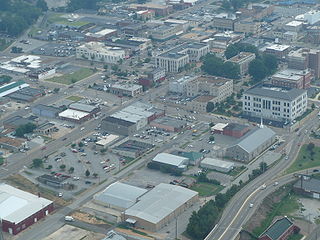Related Research Articles

Mobile is a city and the county seat of Mobile County, Alabama, United States. The population was 187,041 at the 2020 census. After a successful vote to annex areas west of the city limits in July 2023, Mobile's population increased to 204,689 residents, making it the second-most populous city in Alabama, after Huntsville. Mobile is the principal municipality of the Mobile metropolitan area, a region of 430,197 residents composed of Mobile and Washington counties; it is the third-largest metropolitan area in the state.

The history of what is now Alabama stems back thousands of years ago when it was inhabited by indigenous peoples. The Woodland period spanned from around 1000 BCE to 1000 CE and was marked by the development of the Eastern Agricultural Complex. This was followed by the Mississippian culture of Native Americans, which lasted to around the 1600 CE. The first Europeans to make contact with Alabama were the Spanish, with the first permanent European settlement being Mobile, established by the French in 1702.

Mobile County is located in the southwestern corner of the U.S. state of Alabama. It is the third-most populous county in the state after Jefferson and Madison counties. As of the 2020 census, its population was 414,809. Its county seat is Mobile, which was founded as a deepwater port on the Mobile River. The only such port in Alabama, it has long been integral to the economy for providing access to inland waterways as well as the Gulf of Mexico.

George County is a county located in the U.S. state of Mississippi. As of the 2020 census, the population was 24,350. Its county seat is Lucedale. The county is named for James Z. George, US Senator from Mississippi. George County was included in the Pascagoula, MS Metropolitan Statistical Area. The county is located adjacent to the Alabama state line.

Jackson is a city in and the county seat of Madison County, Tennessee, United States. Located 70 miles (110 km) east of Memphis, it is a regional center of trade for West Tennessee. Its total population was 68,205 as of the 2020 United States census. Jackson is the primary city of the Jackson, Tennessee metropolitan area, which is included in the Jackson-Humboldt, Tennessee combined statistical area. Jackson is Madison County's largest city, and the second-largest city in West Tennessee after Memphis. It is home to the Tennessee Supreme Court's courthouse for West Tennessee, as Jackson was the major city in the west when the court was established in 1834.
A land grant is a gift of real estate—land or its use privileges—made by a government or other authority as an incentive, means of enabling works, or as a reward for services to an individual, especially in return for military service. Grants of land are also awarded to individuals and companies as incentives to develop unused land in relatively unpopulated countries; the process of awarding land grants are not limited to the countries named below. The United States historically gave out numerous land grants as Homesteads to individuals desiring to prove a farm. The American Industrial Revolution was guided by many supportive acts of legislatures promoting commerce or transportation infrastructure development by private companies, such as the Cumberland Road turnpike, the Lehigh Canal, the Schuylkill Canal and the many railroads that tied the young United States together.

Arthur Wergs Mitchell, Sr., was a U.S. Representative from Illinois and civil rights activist. Representing Illinois's 1st congressional district, for his entire congressional career from 1935 to 1943, he was the only African American in Congress. A supporter of the New Deal, Mitchell was the first African American to be elected to the United States Congress as a Democrat.

The Illinois Central Railroad, sometimes called the Main Line of Mid-America, was a railroad in the Central United States. Its primary routes connected Chicago, Illinois, with New Orleans, Louisiana, and Mobile, Alabama, and thus, the Great Lakes to the Gulf of Mexico. Another line connected Chicago west to Sioux City, Iowa (1870), while smaller branches reached Omaha, Nebraska (1899) from Fort Dodge, Iowa, and Sioux Falls, South Dakota (1877), from Cherokee, Iowa. The IC also ran service to Miami, Florida, on trackage owned by other railroads.

The Gulf, Mobile and Ohio was a Class I railroad in the central United States whose primary routes extended from Mobile, Alabama, and New Orleans, Louisiana, to St. Louis and Kansas City, Missouri, as well as Chicago, Illinois.
The Preemption Act of 1841, also known as the Distributive Preemption Act, was a US federal law approved on September 4, 1841. It was designed to "appropriate the proceeds of the sales of public lands... and to grant 'pre-emption rights' to individuals" who were living on federal lands

The Alabama Southern Railroad is a class III railroad that operates in the southern United States. The ABS is one of several short line railroads owned by Watco. The railroad operates an 85-mile (137 km) line leased from the Canadian Pacific Kansas City (CPKC). It began operating in 2005.

The Mobile and Ohio Railroad was a railroad in the Southern U.S. The M&O was chartered in January and February 1848 by the states of Alabama, Kentucky, Mississippi, and Tennessee. It was planned to span the distance between the seaport of Mobile, Alabama and the Ohio River near Cairo, Illinois. On September 13, 1940, it was merged with the Gulf, Mobile and Northern Railroad to form the Gulf, Mobile and Ohio Railroad.

Union Station, also called the Meridian Multi-Modal Transportation Center, is an intermodal transportation center in Meridian, Mississippi. The station is located at 1901 Front Street in the Union Station Historic District within the larger Meridian Downtown Historic District, both of which are listed on the National Register of Historic Places. Consisting of a new addition and renovated surviving wing of the 1906 building, Union Station was officially dedicated on December 11, 1997. It is a center of several modes of passenger transportation, including Amtrak train service on the Norfolk Southern rail corridor, Greyhound, and other providers of bus services.

The Alabama Great Southern Railroad is a railroad in the U.S. states of Alabama, Georgia, Louisiana, Mississippi, and Tennessee. It is an operating subsidiary of the Norfolk Southern Corporation (NS), running southwest from Chattanooga to New Orleans through Birmingham and Meridian. The AGS also owns about a 30% interest in the Kansas City Southern-controlled Meridian-Shreveport Meridian Speedway.

The Mobile–Tensaw River Delta is the largest river delta and wetland in Alabama. It encompasses approximately 260,000 acres (110,000 ha) in a 40-by-10-mile area and is the second largest delta in the contiguous United States. This large river delta is approximately 45 miles long and averages 8 miles wide, being 16 miles wide at its widest point. It covers approximately 300 square miles. Of its 260,000 acres, 20,000 acres consist of open water, 10,000 acres of marsh, 70,000 acres of swamp; and more than 85,000 acres of bottomland forest. It drains an area of about 44,000 sq miles, which includes 64% of Alabama and small portions of Georgia and Mississippi.
The West Tennessee Railroad is a shortline railroad in the Southern U.S., connecting Corinth, Mississippi, to Fulton, Kentucky, via western Tennessee. The company began operating in 1984 on a portion of the former Mobile and Ohio Railroad (M&O) main line between Jackson and Kenton, Tennessee. It significantly expanded operations in 2001 through the lease, from the Norfolk Southern Railway, of the ex-M&O south to Corinth and a former main line of the Illinois Central Railroad (IC) north to Fulton, as well as a branch from Jackson to Poplar Corner. All of these lines were part of the Illinois Central Gulf Railroad (ICG) prior to its 1980s program of spin-offs, during which Gibson County purchased the Jackson-Kenton line and the Southern Railway acquired the Corinth-Fulton line and Poplar Corner branch.
The Gulf and Mississippi Railroad was the first regional railroad in the United States upon its creation in 1985. With over 713 miles (1,147 km) of track in the states of Mississippi, Tennessee, and Alabama it was among the largest spin-off railroads in the post-Staggers Act era. MidSouth Rail acquired the entire G&M railroad in 1988, operating it as a separate entity, SouthRail. Kansas City Southern purchased MidSouth Rail in 1994 and most of the former G&M lines are still in service under KCS.
The Underground Railroad Bicycle Route is a 2,000-mile bicycle touring route from Mobile, Alabama, to Owen Sound, Ontario. It was developed by Adventure Cycling Association with the Center for Minority Health at the University of Pittsburgh. The route was built to loosely follow the Underground Railroad, the network of paths that African American slaves used to escape to the Northern United States and Canada.
The Alabama and Florida Railroad was a line of rail track connecting Pensacola, Florida with Montgomery, Alabama during the late 1850s and early 1860s. The portion of the line in Alabama was first owned by the Alabama and Florida Rail Road Company, while the portion of the line in Florida was owned by the Alabama and Florida Railroad.

Railroad land grants in the United States made in the 1850s to 1870s, were instrumental in the building the nation's railway network in the Central United States west of Chicago. They enabled the rapid settlement of new farm and ranch lands as well as mining centers. Overall, government land grants to Western US railroads during the 1850s to 1880s played a crucial role in shaping the economic, social, and geographic landscape of the United States, laying the foundation for much of the nation's modern transportation infrastructure and facilitating the westward expansion of settlement and industry.
References
- ↑ An Act Granting Right of Way, and making a Grant of Land to the States of Illinois, Mississippi, and Alabama, in Aid of the Construction of a Railroad from Chicago to Mobile (9 Stat. 466)
- ↑ Julian E. Zelizer, The American Congress: the building of democracy, p.288
- ↑ Stover, John F.; Carnes, Mark Christopher (1999). The Routledge historical atlas of the American railroads: Routledge atlases of American history. New York: Routledge. ISBN 0415921406.